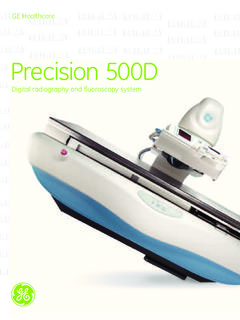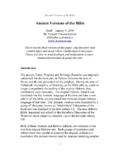Transcription of MICROBES IN HUMAN WELFARE - Prashanth Ellina
1 Besides macroscopic plants and animals, MICROBES arethe major components of biological systems on this have studied about the diversity of living organismsin Class XI. Do you remember which Kingdoms amongthe living organisms contain micro-organisms? Which arethe ones that are only microscopic? MICROBES are presenteverywhere in soil, water, air, inside our bodies and thatof other animals and plants. They are present even at siteswhere no other life-form could possibly exist sites suchas deep inside the geysers (thermal vents) where thetemperature may be as high as 1000C, deep in the soil,under the layers of snow several metres thick, and in highlyacidic environments. MICROBES are diverse protozoa,bacteria, fungi and microscopic plants viruses, viroids andalso prions that are proteinacious infectious agents.
2 Someof the MICROBES are shown in Figures and like bacteria and many fungi can be grownon nutritive media to form colonies (Figure ), that canbe seen with the naked eyes. Such cultures are useful instudies on 10 MICROBES IN HUMAN in in MICROBES in MICROBES in Production MICROBES as as Biofertilisers180 BIOLOGY(a)(b)(c)(a)(b)Figure (a) Colonies of bacteria growing in a petri dish;(b) Fungal colony growing in a petri dish(a)(b)(c) : (a) Rod-shaped,magnified 1500X; (b) Sphericalshaped, magnified1500X; (c) A rod-shaped bacterium showing flagella,magnified 50,000 XFigure : (a) A bacteriophage; (b)Adenovirus which causes respiratoryinfections; (c) Rod-shaped TobaccoMosaic Virus (TMV). Magnified about1,00,000 1,50,000X181 MICROBES IN HUMAN WELFARE In chapter 8, you have read that MICROBES cause a large number ofdiseases in HUMAN beings.
3 They also cause diseases in animals and this should not make you think that all MICROBES are harmful; severalmicrobes are useful to man in diverse ways. Some of the most importantcontributions of MICROBES to HUMAN WELFARE are discussed in this MICROBES IN HOUSEHOLD PRODUCTSYou would be surprised to know that we use MICROBES or productsderived from them everyday. A common example is the production ofcurd from milk. Micro-organisms such as Lactobacillus and otherscommonly called lactic acid bacteria (LAB) grow in milk and convert itto curd. During growth, the LAB produce acids that coagulate andpartially digest the milk proteins. A small amount of curd added to thefresh milk as inoculum or starter contain millions of LAB, which atsuitable temperatures multiply, thus converting milk to curd, whichalso improves its nutritional quality by increasing vitamin B12.
4 In ourstomach too, the LAB play very beneficial role in checking disease-causing dough, which is used for making foods such as dosa and idli isalso fermented by bacteria. The puffed-up appearance of dough is due tothe production of CO2 gas. Can you tell which metabolic pathway istaking place resulting in the formation of CO2? Where do you think thebacteria for these fermentations came from? Similarly the dough, whichis used for making bread, is fermented using baker s yeast(Saccharomyces cerevisiae). A number of traditional drinks and foodsare also made by fermentation by the MICROBES . Toddy , a traditionaldrink of some parts of southern India is made by fermenting sap frompalms. MICROBES are also used to ferment fish, soyabean and bamboo-shoots to make foods.
5 Cheese, is one of the oldest food items in whichmicrobes were used. Different varieties of cheese are known by theircharacteristic texture, flavour and taste, the specificity coming from themicrobes used. For example, the large holes in Swiss cheese are due toproduction of a large amount of CO2 by a bacterium namedPropionibacterium sharmanii. The Roquefort cheese are ripened bygrowing a specific fungi on them, which gives them a particular MICROBES IN INDUSTRIAL PRODUCTSEven in industry, MICROBES are used to synthesise a number of productsvaluable to HUMAN beings. Beverages and antibiotics are some on an industrial scale, requires growing MICROBES in very largevessels called fermentors (Figure ). Fermented BeveragesMicrobes especially yeasts have been used fromtime immemorial for the production of beverageslike wine, beer, whisky, brandy or rum.
6 For thispurpose the same yeast Saccharomycescerevisiae used for bread-making andcommonly called brewer s yeast, is used forfermenting malted cereals and fruit juices, toproduce ethanol. Do you recollect the metabolicreactions, which result in the production ofethanol by yeast? Depending on the type of theraw material used for fermentation and the typeof processing (with or without distillation)different types of alcoholic drinks are and beer are produced without distillationwhereas whisky, brandy and rum are producedby distillation of the fermented broth. Thephotograph of a fermentation plant is shown inFigure AntibioticsAntibiotics produced by MICROBES are regardedas one of the most significant discoveries of thetwentieth century and have greatly contributedtowards the WELFARE of the HUMAN society.
7 Anti isa Greek word that means against , and bio means life , together they mean against life (in thecontext of disease causing organisms); whereas with reference to humanbeings, they are pro life and not against. Antibiotics are chemicalsubstances, which are produced by some MICROBES and can kill or retardthe growth of other (disease-causing) are familiar with the commonly used antibiotic Penicillin. Do youknow that Penicillin was the first antibiotic to be discovered, and it was achance discovery? Alexander Fleming while working on Staphylococcibacteria, once observed a mould growing in one of his unwashed cultureplates around which Staphylococci could not grow. He found out that itwas due to a chemical produced by the mould and he named it Penicillinafter the mould Penicillium notatum.
8 However, its full potential as aneffective antibiotic was established much later by Ernest Chain andHoward Florey. This antibiotic was extensively used to treat Americansoldiers wounded in World War II. Fleming, Chain and Florey were awardedthe Nobel Prize in 1945, for this Fermentation PlantFigure Fermentors183 MICROBES IN HUMAN WELFAREA fter Penicillin, other antibiotics were also purified from othermicrobes. Can you name some other antibiotics and find out theirsources? Antibiotics have greatly improved our capacity to treat deadlydiseases such as plague, whooping cough (kali khansi), diphtheria (galghotu) and leprosy (kusht rog), which used to kill millions all over theglobe. Today, we cannot imagine a world without Chemicals, Enzymes and other Bioactive MoleculesMicrobes are also used for commercial and industrial production ofcertain chemicals like organic acids, alcohols and enzymes.
9 Examples ofacid producers are Aspergillus niger (a fungus) of citric acid, Acetobacteraceti (a bacterium) of acetic acid; Clostridium butylicum (a bacterium) ofbutyric acid and Lactobacillus (a bacterium) of lactic (Saccharomyces cerevisiae) is used for commercial productionof ethanol. MICROBES are also used for production of enzymes. Lipases areused in detergent formulations and are helpful in removing oily stainsfrom the laundry. You must have noticed that bottled fruit juices boughtfrom the market are clearer as compared to those made at home. This isbecause the bottled juices are clarified by the use of pectinases andproteases. Streptokinase produced by the bacterium Streptococcus andmodified by genetic engineering is used as a clot buster for removingclots from the blood vessels of patients who have undergone myocardialinfraction leading to heart bioactive molecule, cyclosporin A, that is used as animmunosuppressive agent in organ-transplant patients, is produced bythe fungus Trichoderma polysporum.
10 Statins produced by the yeastMonascus purpureus have been commercialised as blood-cholesterollowering agents. It acts by competitively inhibiting the enzyme responsiblefor synthesis of MICROBES IN SEWAGE TREATMENTWe know that large quantities of waste water are generated everyday incities and towns. A major component of this waste water is HUMAN municipal waste-water is also called sewage. It contains largeamounts of organic matter and MICROBES . Many of which are you ever wondered where this huge quantity of sewage or urbanwaste water is disposed off daily? This cannot be discharged into naturalwater bodies like rivers and streams directly you can understand disposal, hence, sewage is treated in sewage treatment plants (STPs)to make it less polluting.


















